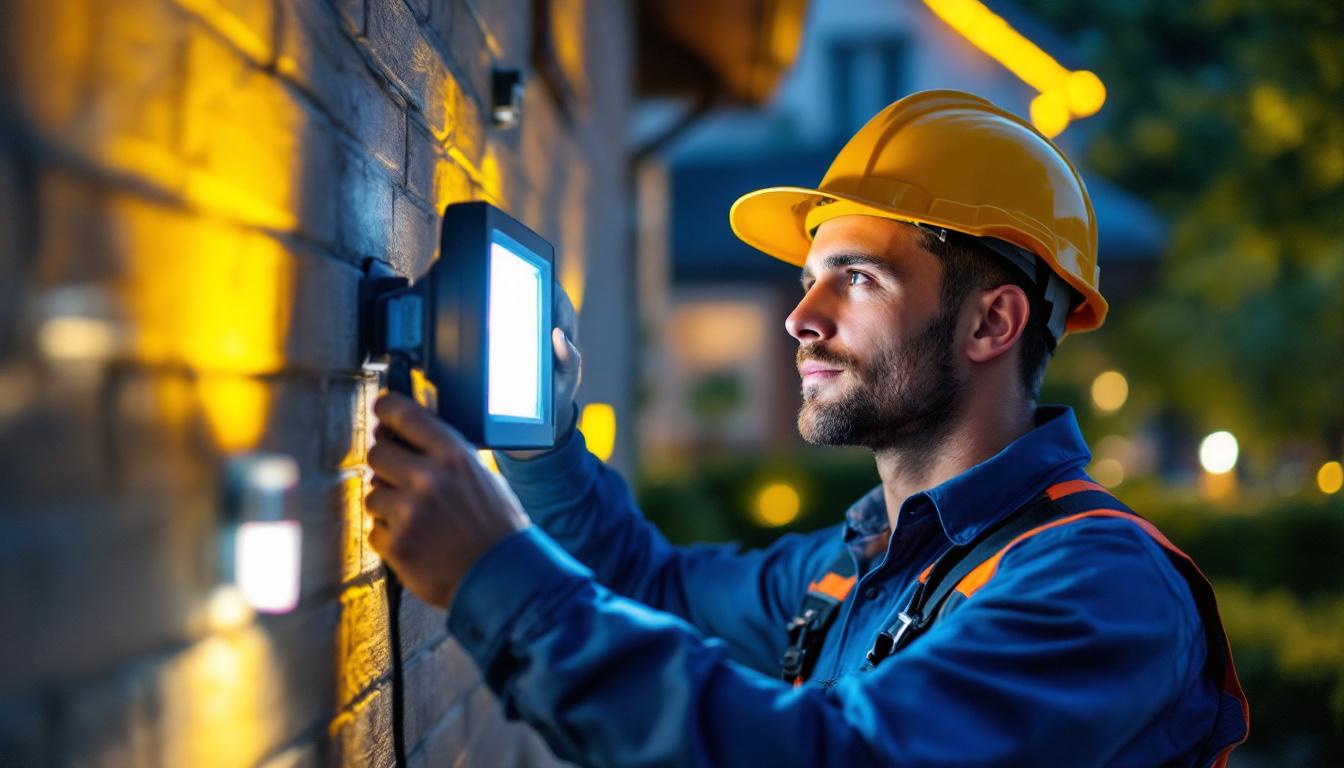
As the demand for energy-efficient and smart lighting solutions continues to grow, automatic flood lights have become an essential component in outdoor lighting design. For lighting contractors, understanding the intricacies of these fixtures can significantly enhance service offerings and client satisfaction. This article provides valuable insights into automatic flood lights, their benefits, installation tips, and maintenance practices.
Automatic flood lights are designed to illuminate large outdoor areas, providing security and visibility. These lights are equipped with sensors that enable them to turn on and off based on ambient light levels or motion detection. This functionality not only enhances safety but also contributes to energy savings. The technology behind these lights has evolved significantly over the years, incorporating advancements that improve their efficiency and effectiveness. For instance, many modern flood lights utilize LED technology, which not only lasts longer than traditional bulbs but also consumes significantly less energy, making them a sustainable choice for outdoor lighting.
There are several types of automatic flood lights available in the market, each with unique features and applications. The most common types include:
Incorporating automatic flood lights into lighting projects offers numerous advantages. Firstly, they provide enhanced security by illuminating dark areas, deterring potential intruders. Secondly, their energy-efficient design helps reduce electricity costs, making them an environmentally friendly choice. The long lifespan of LED flood lights also means less frequent replacements, further contributing to cost savings over time.
Moreover, automatic flood lights are convenient for homeowners and businesses alike. The automation feature means users do not have to remember to turn lights on or off, ensuring consistent lighting when needed. This is particularly beneficial for properties that are unoccupied for extended periods. Additionally, many models come with adjustable settings, allowing users to customize the sensitivity of motion detection or the timing of the lights, ensuring that they meet specific needs and preferences. This adaptability makes automatic flood lights not only a practical solution for security but also a versatile option for enhancing outdoor aesthetics and functionality.
Proper installation is crucial for the effective performance of automatic flood lights. Lighting contractors must consider several factors to ensure optimal functionality and longevity of the fixtures.
Choosing the right location for flood lights is essential. They should be installed in areas that require illumination, such as driveways, entrances, and backyards. It is important to avoid placing lights too close to obstructions, which can block the light beam and reduce effectiveness.
Additionally, contractors should consider the height at which the flood lights are mounted. Generally, a height of 8 to 12 feet is recommended for optimal coverage. This height helps avoid vandalism while still providing sufficient illumination. Furthermore, the angle of the lights should be adjustable to ensure that the light is directed where it is most needed, minimizing light pollution and maximizing efficiency.
Another critical aspect of placement is the consideration of the surrounding landscape. Trees, shrubs, and other vegetation can cast shadows and interfere with the light output. Therefore, it may be beneficial to trim or strategically place plants to enhance the effectiveness of the flood lights. By taking these factors into account, contractors can create a well-lit environment that enhances safety and aesthetics.
When installing automatic flood lights, proper wiring is crucial. Contractors should ensure that the electrical supply is adequate for the wattage of the flood lights being installed. It is advisable to use weatherproof wiring and connectors to prevent damage from the elements.
Moreover, contractors should follow local building codes and regulations regarding electrical installations. This not only ensures safety but also avoids potential legal issues down the line. It is also wise to consider the use of timers or motion sensors to enhance energy efficiency and provide additional security features. These devices can help automate the lighting system, ensuring that lights are only on when needed, thereby reducing energy consumption and extending the lifespan of the fixtures.
In addition to the technical aspects, contractors should also think about the accessibility of the wiring for future maintenance. Using conduit or raceways can protect the wiring and make it easier to replace or upgrade components without extensive labor. Proper planning in this area can save time and resources in the long run, making the installation process smoother and more efficient.
The effectiveness of automatic flood lights largely depends on the sensors used. Selecting the right type of sensor and configuring it correctly can significantly enhance the performance of the lighting system.
There are various types of sensors available, including passive infrared (PIR) sensors, microwave sensors, and dual technology sensors. PIR sensors are commonly used for motion detection, while microwave sensors can detect movement through obstacles.
Contractors should consider the specific needs of the installation site when selecting sensors. For example, PIR sensors may be more suitable for residential areas, while microwave sensors may be better for commercial properties with complex layouts. Additionally, environmental factors such as temperature and humidity can affect sensor performance. In colder climates, for instance, PIR sensors may have a reduced range, while microwave sensors can maintain their effectiveness regardless of temperature fluctuations. Understanding these nuances can help in making a more informed choice that aligns with the unique characteristics of the installation site.
Once the appropriate sensors are selected, configuring their settings is essential for optimal performance. Most sensors allow adjustments for sensitivity, duration, and daylight settings. Contractors should ensure that the sensitivity is set appropriately to avoid false triggers from animals or moving branches.
Additionally, the duration setting determines how long the lights will remain on after detecting motion. This can typically be adjusted from a few seconds to several minutes, depending on the client’s preferences. It is also important to consider the daylight sensitivity setting, which ensures that the lights only activate in low-light conditions. This feature can help conserve energy and prolong the lifespan of the bulbs. Moreover, some advanced sensors come equipped with smart technology that allows for remote monitoring and adjustments via mobile applications, providing users with greater control and flexibility over their lighting systems.
To keep automatic flood lights functioning optimally, clients should inspect the fixtures regularly for dirt and debris. Cleaning the lenses can significantly improve light output and visibility. Additionally, checking the sensors for obstructions can prevent false triggers or failures.
Contractors should also recommend periodic checks of the wiring and connections to ensure they are secure and free from corrosion. This proactive approach can help identify potential issues before they escalate into costly repairs.
Even with proper maintenance, issues may arise with automatic flood lights. Common problems include lights not turning on, flickering, or remaining on continuously. For lights that do not turn on, contractors should first check the power supply and ensure the circuit breaker has not tripped.
If lights flicker, it may indicate a loose connection or an issue with the sensor settings. Adjusting the sensitivity or checking for obstructions can often resolve this issue. For lights that remain on, it is essential to inspect the sensor settings to ensure they are configured correctly.
Providing clients with education and support is a critical aspect of a lighting contractor’s role. Ensuring that clients understand how to use and maintain their automatic flood lights can enhance satisfaction and reduce service calls.
Contractors should take the time to explain the various features of automatic flood lights to clients. This includes discussing the benefits of different sensor types, how to adjust settings, and the importance of regular maintenance. Providing clients with a user manual or a quick reference guide can be beneficial.
Additionally, demonstrating how to operate the lights during the installation process can help clients feel more comfortable and confident in their new lighting system.
Establishing a relationship with clients beyond the initial installation can lead to long-term success. Contractors should be available for questions and support after the installation is complete. This can include offering maintenance services, troubleshooting assistance, or even upgrades to newer technology as it becomes available.
By fostering a supportive relationship, contractors can build trust and encourage clients to refer their services to others.
Automatic flood lights are an invaluable addition to outdoor lighting solutions, providing security, convenience, and energy efficiency. For lighting contractors, understanding the various aspects of these fixtures—from installation and sensor selection to maintenance and client education—can enhance service offerings and client satisfaction.
By staying informed about the latest technologies and best practices, contractors can position themselves as experts in the field, ensuring they meet the evolving needs of their clients. As the demand for smart lighting solutions continues to rise, embracing automatic flood lights will not only benefit contractors but also their clients, leading to safer and more illuminated outdoor spaces.
Ready to elevate your lighting projects with the most efficient automatic flood lights on the market? Look no further than LumenWholesale, where we provide lighting contractors with the highest quality, spec-grade lighting products at unbeatable wholesale prices. Our commitment to cutting out the middleman means you get superior lighting without the inflated markups, ensuring every project shines with reliability and high performance. Plus, with free shipping on bulk orders, you can stock up on premium lighting solutions at the best value — without any hidden fees or compromises. Don’t miss out on the perfect blend of quality, affordability, and convenience. Visit LumenWholesale now for Wholesale Lighting at the Best Value and transform your outdoor spaces with confidence and ease.

Discover how tape lights can transform your lighting projects from ordinary to extraordinary.

Discover the ultimate guide for lighting contractors on transitioning from fluorescent to LED lighting.

Discover the secrets to mastering energetic lighting with expert insights tailored for lighting contractors.

Discover expert techniques and proven strategies for lighting contractors to illuminate flagpoles effectively.